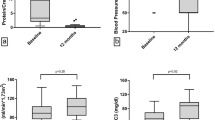Abstract
Background
Arg95Stop mutation of exon 4 in complement component 9 (C9) gene is common in individuals in Japan with C9 deficiency (C9D); however, understanding of the influences of C9D on human glomerulonephritis remains elusive.
Methods
A total of 1288 patients with chronic kidney disease (CKD) were recruited from the hospitals in Niigata prefecture. They were screened for the Arg95Stop mutation of C9 gene by allele-specific PCR.
Results
We identified two individuals with C9D among 1,288 CKD patients, a frequency comparable to that of the general Japanese population (0.16%). Case 1 involved a 44-year-old man presenting with nephrotic proteinuria. The hemolytic activity of CH50 was low, and the concentration of C9 was not detected. Sequencing of exon 4 of the C9 gene showed the Arg95Stop mutation. Renal biopsy revealed diffuse global mesangial proliferation with extensive duplication of glomerular capillary walls. Mesangial, subendothelial and subepithelial deposits were noticed with light and electron microscopy. Immunofluorescent study showed predominant mesangial IgA deposition. Case 2 involved a 62-year-old man presenting with proteinuria and hematuria. His CH50 level was decreased. Renal biopsy revealed diffuse global mesangial proliferation with extensive duplication of glomerular capillary walls. Immune deposits were also confirmed. The percentage of C9D among patients with mesangial proliferation and duplication of GBM in this study was 5.1%.
Conclusion
These results suggested that the lack of membrane attack complex because of an Arg95Stop mutation of the C9 gene predisposed patients to pathognomonic glomerulonephritis.





Similar content being viewed by others
References
Fukumori Y, Yoshimura K, Ohnoki S, et al. A high incidence of C9 deficiency among healthy blood donors in Osaka, Japan. Int Immunol. 1989;1:85–9.
Nagata M, Hara T, Aoki T, et al. Inherited deficiency of ninth component of complement: an increased risk of meningococcal meningitis. J Pediatr. 1989;114:260–4.
Kira R, Ihara K, Takada H, et al. Nonsense mutation in exon 4 of human complement C9 gene is the major cause of Japanese complement C9 deficiency. Hum Genet. 1998;102:605–10.
Hironaka K, Makino H, Amano T, et al. Immune complex glomerulonephritis in a pregnant woman with congenital C9 deficiency. Intern Med. 1993;32:806–9.
Kanda E, Shimamura H, Tamura H, et al. IgA nephropathy with complement deficiency. Intern Med. 2001;40:52–5.
Maruyama K, Arai H, Ogawa T, et al. C9 deficiency in a patient with poststreptococcal glomerulonephritis. Pediatr Nephrol. 1995;9:746–8.
Yoshioka K, Takemura T, Akano N, et al. IgA nephropathy in patients with congenital C9 deficiency. Kidney Int. 1992;42:1253–8.
Witzel-Schlomp K, Spath PJ, Hobart MJ, et al. The human complement C9 gene: identification of two mutations causing deficiency and revision of the gene structure. J Immunol. 1997;158:5043–9.
Brandt J, Pippin J, Schulze M, et al. Role of the complement membrane attack complex (C5b-9) in mediating experimental mesangioproliferative glomerulonephritis. Kidney Int. 1996;49:335–43.
Alexopoulos E, Papaghianni A, Papadimitriou M. The pathogenetic significance of C5b-9 in IgA nephropathy. Nephrol Dial Transplant. 1995;10:1166–72.
Ichikawa E, Furuta J, Kawachi Y, et al. Hereditary complement (C9) deficiency associated with dermatomyositis. Br J Dermatol. 2001;144:1080–3.
Kanemitsu S, Ihara K, Kira R, et al. Complement component 9 deficiency is not a susceptibility factor for SLE. Lupus. 2000;9:456–7.
Coleman TH, Forristal J, Kosaka T, et al. Inherited complement component deficiencies in membranoproliferative glomerulonephritis. Kidney Int. 1983;24:681–90.
Ault BH. Factor H and the pathogenesis of renal diseases. Pediatr Nephrol. 2000;14:1045–53.
Rose KL, Paixao-Cavalcante D, Fish J, et al. Factor I is required for the development of membranoproliferative glomerulonephritis in factor H-deficient mice. J Clin Invest. 2008;118:608–18.
Zhou XJ, Silva FG. Membranoproliferative glomerulonephritis. In: Jennette JC, Olson JL, Schwartz MM, Silva FG, editors. Heptinstall’s pathology of the kidney. Philadelphia: Lippincott Williams & Wilkins; 2007. p. 253–319.
Alexopoulos E, Seron D, Hartley RB, et al. The role of interstitial infiltrates in IgA nephropathy: a study with monoclonal antibodies. Nephrol Dial Transplant. 1989;4:187–95.
Nath KA. Tubulointerstitial changes as a major determinant in the progression of renal damage. Am J Kidney Dis. 1992;20:1–17.
Striker GE, Schainuck LI, Cutler RE, et al. Structural-functional correlations in renal disease. I. A method for assaying and classifying histopathologic changes in renal disease. Hum Pathol. 1970;1:615–30.
Nangaku M, Pippin J, Couser WG. Complement membrane attack complex (C5b-9) mediates interstitial disease in experimental nephrotic syndrome. J Am Soc Nephrol. 1999;10:2323–31.
Nangaku M, Pippin J, Couser WG. C6 mediates chronic progression of tubulointerstitial damage in rats with remnant kidneys. J Am Soc Nephrol. 2002;13:928–36.
Rangan GK, Pippin JW, Couser WG. C5b-9 regulates peritubular myofibroblast accumulation in experimental focal segmental glomerulosclerosis. Kidney Int. 2004;66:1838–48.
Torbohm I, Schonermark M, Wingen AM, et al. C5b-8 and C5b-9 modulate the collagen release of human glomerular epithelial cells. Kidney Int. 1990;37:1098–104.
Kilgore KS, Schmid E, Shanley TP, et al. Sublytic concentrations of the membrane attack complex of complement induce endothelial interleukin-8 and monocyte chemoattractant protein-1 through nuclear factor-kappa B activation. Am J Pathol. 1997;150:2019–31.
Acknowledgments
This study was supported by a Grant-in-Aid for Scientific Research on Priority Areas (no. 20018009 to I. Narita), a Grant-in-Aid for Scientific Research B (no. 20390234 to I. Narita) and a Grant-in-Aid for Scientific Research C (no. 20590951 to S. Goto) from the Ministry of Education, Culture, Sports, Science and Technology of Japan. We gratefully acknowledge the excellent technical assistance of Naofumi Imai, Yao Feifei and Katsura Minowa.
Author information
Authors and Affiliations
Corresponding author
About this article
Cite this article
Miura, T., Goto, S., Iguchi, S. et al. Membranoproliferative pattern of glomerular injury associated with complement component 9 deficiency due to Arg95Stop mutation. Clin Exp Nephrol 15, 86–91 (2011). https://doi.org/10.1007/s10157-010-0358-0
Received:
Accepted:
Published:
Issue Date:
DOI: https://doi.org/10.1007/s10157-010-0358-0




